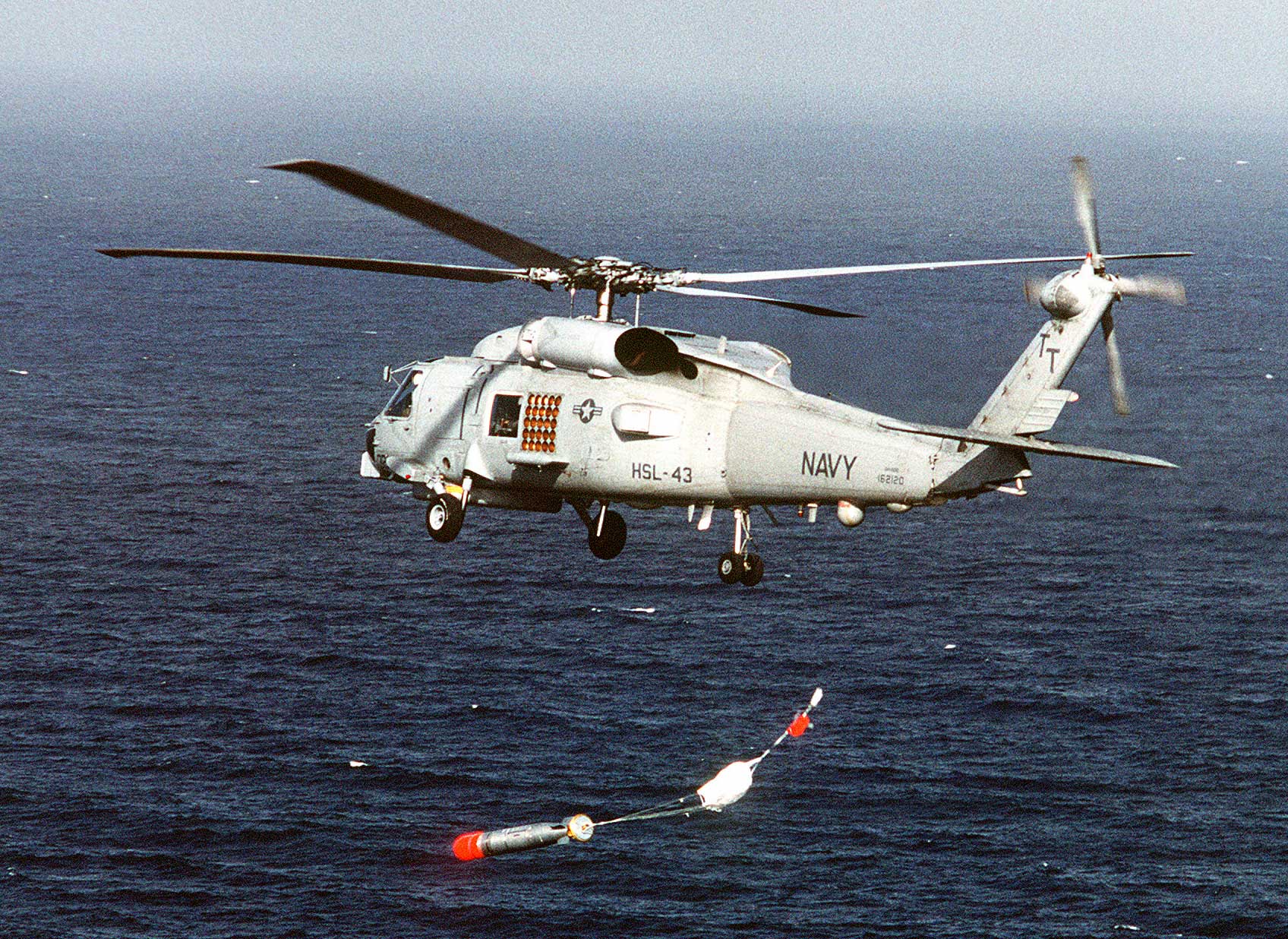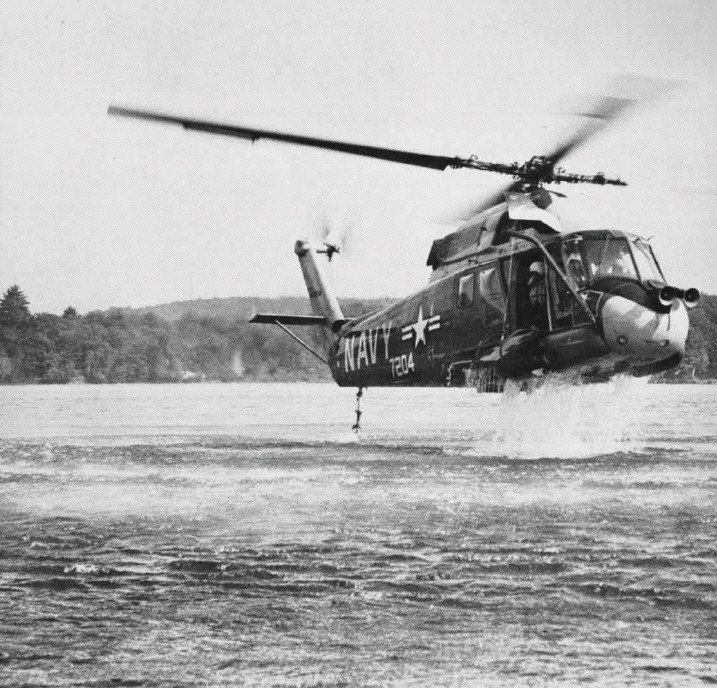|
Light Airborne Multi-Purpose System
The Light Airborne Multi-Purpose System (LAMPS) is the United States Navy's program that develops crewed helicopters to assist the surface fleet in anti-submarine warfare. The purpose of LAMPS is to scout outside the limits of a fleet's radar and sonar range to detect and track enemy submarines or missile-equipped escort ships and feed the real-time data back to their LAMPS mothership. They also have the capability to directly engage enemy targets with depth charges or torpedoes, or indirectly engage the enemy by coordinating fleet assets on site. A Mk II version was planned, but was canceled in favor of the more advanced Mk III. LAMPS III added the capabilities to use anti-ship missile systems (like the AGM-119 Penguin anti-ship missile) and night vision capability. History In October 1970, the UH-2 was selected to be the platform to function as the interim Light Airborne Multi-Purpose System (LAMPS) helicopter.Frawley 2002, p. 100. During the course of the 1960s, LAMP ... [...More Info...] [...Related Items...] OR: [Wikipedia] [Google] [Baidu] |
Bell Helicopter
Bell Textron Inc. is an American aerospace manufacturer headquartered in Fort Worth, Texas. A subsidiary of Textron, Bell manufactures military rotorcraft at facilities in Fort Worth, and Amarillo, Texas, as well as commercial helicopters in Mirabel, Quebec, Canada. History Bell Aircraft The company was founded on July 10, 1935, as Bell Aircraft Corporation by Lawrence Dale Bell in Buffalo, New York. The company focused on the designing and building of fighter aircraft. Their first fighters were the XFM-1 Airacuda, a twin-engine fighter for attacking bombers, and the P-39 Airacobra. The P-59 Airacomet, the first American jet fighter, the P-63 Kingcobra, the successor to the P-39, and the Bell X-1 were also Bell products.History of Bell Helicopter . bellhelicopter.com [...More Info...] [...Related Items...] OR: [Wikipedia] [Google] [Baidu] |
Sikorsky SH-60 Seahawk
The Sikorsky SH-60/MH-60 Seahawk (or Sea Hawk) is a twin turboshaft engine, multi-mission United States Navy helicopter based on the United States Army UH-60 Black Hawk and a member of the Sikorsky S-70 family. The most significant modifications are the folding main rotor and a hinged tail to reduce its footprint aboard ships. The U.S. Navy uses the H-60 airframe under the model designations SH-60B, SH-60F, HH-60H, MH-60R, and MH-60S. Able to deploy aboard any air-capable frigate, destroyer, cruiser, fast combat support ship, expeditionary transfer dock, amphibious assault ship, littoral combat ship or aircraft carrier, the Seahawk can handle anti-submarine warfare (ASW), anti-surface warfare (ASUW), naval special warfare (NSW) insertion, search and rescue (SAR), combat search and rescue (CSAR), vertical replenishment (VERTREP), and medical evacuation (MEDEVAC). Design and development Origins During the 1970s, the U.S. Navy began looking for a new helicopter to replace the ... [...More Info...] [...Related Items...] OR: [Wikipedia] [Google] [Baidu] |
Sikorsky SH-60 Seahawk
The Sikorsky SH-60/MH-60 Seahawk (or Sea Hawk) is a twin turboshaft engine, multi-mission United States Navy helicopter based on the United States Army UH-60 Black Hawk and a member of the Sikorsky S-70 family. The most significant modifications are the folding main rotor and a hinged tail to reduce its footprint aboard ships. The U.S. Navy uses the H-60 airframe under the model designations SH-60B, SH-60F, HH-60H, MH-60R, and MH-60S. Able to deploy aboard any air-capable frigate, destroyer, cruiser, fast combat support ship, expeditionary transfer dock, amphibious assault ship, littoral combat ship or aircraft carrier, the Seahawk can handle anti-submarine warfare (ASW), anti-surface warfare (ASUW), naval special warfare (NSW) insertion, search and rescue (SAR), combat search and rescue (CSAR), vertical replenishment (VERTREP), and medical evacuation (MEDEVAC). Design and development Origins During the 1970s, the U.S. Navy began looking for a new helicopter to replace the ... [...More Info...] [...Related Items...] OR: [Wikipedia] [Google] [Baidu] |
Kaman SH-2 Seasprite
The Kaman SH-2 Seasprite is a ship-based helicopter originally developed and produced by American manufacturer Kaman Aircraft Corporation. It has been typically used as a compact and fast-moving rotorcraft for utility and anti-submarine warfare missions. Development of the Seasprite had been initiated during the late 1950s in response to a request from the United States Navy, calling for a suitably fast and compact naval helicopter for utility missions. Kaman's submission, internally designated as the ''K-20'', was favourably evaluated, leading to the issuing of a contract for the construction of four prototypes and an initial batch of 12 production helicopters, designated as the ''HU2K-1''. Under the 1962 United States Tri-Service aircraft designation system, the HU2K was redesignated H-2, the HU2K-1 becoming the UH-2A. Beyond the U.S. Navy, the company had also made efforts to acquire other customers for export sales, in particular the Royal Canadian Navy; however, the init ... [...More Info...] [...Related Items...] OR: [Wikipedia] [Google] [Baidu] |
Messerschmitt-Bölkow-Blohm
Messerschmitt-Bölkow-Blohm (MBB) was a West German aerospace manufacturer. It was formed during the late 1960s as the result of efforts to consolidate the West German aerospace industry; aircraft manufacturer Messerschmitt AG merged with the civil engineering and aviation firm Bölkow during 1968, while rival aircraft manufacturer Hamburger Flugzeugbau was acquired by the company in the following year. The company was responsible for the development and manufacture of various aircraft during its existence. Among its best-known products was the MBB Bo 105 light twin-engine helicopter and its enlarged derivative, the MBB/Kawasaki BK 117. MBB was also a key early partner on the Airbus A300, a wide-body twin-jet airliner; the company's involvement in the A300's development and production led to it forming a key component of the multinational Airbus consortium. It was also involved in numerous experimental aircraft programmes, such as the MBB Lampyridae, an aborted stealth airc ... [...More Info...] [...Related Items...] OR: [Wikipedia] [Google] [Baidu] |
Westland Aircraft
Westland Aircraft was a British aircraft manufacturer located in Yeovil, Somerset. Formed as a separate company by separation from Petters Limited just before the start of the Second World War, Westland had been building aircraft since 1915. During the war the company produced a number of generally unsuccessful designs, but their Lysander would serve as an important liaison aircraft with the Royal Air Force. After the war the company focused on helicopters, and was merged with several other British firms to create Westland Helicopters in 1961. History Foundation In 1915 the Westland Aircraft Works was founded as a division of Petters in response to government orders for the construction under licence of initially 12 Short Type 184 seaplanes, followed by 20 Short Admiralty Type 166. Orders for other aircraft followed during First World War, including the Sopwith 1½ Strutter, the de Havilland designed Airco DH.4, Airco DH.9 and Airco DH.9A and the Vickers Vimy. Th ... [...More Info...] [...Related Items...] OR: [Wikipedia] [Google] [Baidu] |
Kaman Aircraft
Kaman Corporation is an American aerospace company, with headquarters in Bloomfield, Connecticut. It was founded in 1945 by Charles Kaman. During the first ten years the company operated exclusively as a designer and manufacturer of several helicopters that set world records and achieved many aviation firsts. In 1956, Kaman began to diversify as an aerospace subcontractor of McDonnell Douglas, Grumman, and others. In the mid-1960s Kaman diversified outside of the aerospace industry, using the expertise Kaman had gained in composite materials and the end of the need for skilled woodworkers to craft wooden rotor blades. Charles Kaman, a guitarist as well as an aerospace pioneer, worked with his engineers and other musicians to create the round-backed, composite-body Ovation guitar, which led to the eventual creation of Kaman Music (now KMCMusicorp). Kaman Music was an independent distributor of musical instruments and accessories, and a major producer of guitars and guitar pa ... [...More Info...] [...Related Items...] OR: [Wikipedia] [Google] [Baidu] |
Boeing Vertol YUH-61
The Boeing Vertol YUH-61 (company designation Model 179) was a twin turbine-engined, medium-lift, military assault/utility helicopter. The YUH-61 was the runner-up in the United States Army Utility Tactical Transport Aircraft System (UTTAS) competition in the early 1970s to replace the Bell UH-1 Iroquois helicopter. At the end of the flyoff program, Sikorsky Aircraft was awarded a contract to develop and build its UH-60A entry. Development Under a contract awarded in August 1972, Boeing Vertol designed and delivered three prototypes to compete UTTAS program.Gunston, Bill: ''The Illustrated Encyclopedia of the World's Modern Military Aircraft'', page 205. Crescent Books, New York, NY USA, ca. 1978. When Boeing Vertol failed to win the Army competition, it pinned its hope on winning civil orders and the US Navy's LAMPS III program. In the end, a variant of the Sikorsky design, the SH-60B, won the Navy contract, and the civil orders received were canceled. Three aircraft were bui ... [...More Info...] [...Related Items...] OR: [Wikipedia] [Google] [Baidu] |
United States Navy
The United States Navy (USN) is the maritime service branch of the United States Armed Forces and one of the eight uniformed services of the United States. It is the largest and most powerful navy in the world, with the estimated tonnage of its active battle fleet alone exceeding the next 13 navies combined, including 11 allies or partner nations of the United States as of 2015. It has the highest combined battle fleet tonnage (4,635,628 tonnes as of 2019) and the world's largest aircraft carrier fleet, with eleven in service, two new carriers under construction, and five other carriers planned. With 336,978 personnel on active duty and 101,583 in the Ready Reserve, the United States Navy is the third largest of the United States military service branches in terms of personnel. It has 290 deployable combat vessels and more than 2,623 operational aircraft . The United States Navy traces its origins to the Continental Navy, which was established during the American R ... [...More Info...] [...Related Items...] OR: [Wikipedia] [Google] [Baidu] |
Sikorsky UH-60 Black Hawk
The Sikorsky UH-60 Black Hawk is a four-blade, twin-engine, medium-lift utility military helicopter manufactured by Sikorsky Aircraft. Sikorsky submitted the S-70 design for the United States Army's Utility Tactical Transport Aircraft System (UTTAS) competition in 1972. The Army designated the prototype as the ''YUH-60A'' and selected the Black Hawk as the winner of the program in 1976, after a fly-off competition with the Boeing Vertol YUH-61. Named after the Native American war leader Black Hawk, the UH-60A entered service with the U.S. Army in 1979, to replace the Bell UH-1 Iroquois as the Army's tactical transport helicopter. This was followed by the fielding of electronic warfare and special operations variants of the Black Hawk. Improved UH-60L and UH-60M utility variants have also been developed. Modified versions have also been developed for the U.S. Navy, Air Force, and Coast Guard. In addition to U.S. Army use, the UH-60 family has been exported to several nations. ... [...More Info...] [...Related Items...] OR: [Wikipedia] [Google] [Baidu] |
Sonar
Sonar (sound navigation and ranging or sonic navigation and ranging) is a technique that uses sound propagation (usually underwater, as in submarine navigation) to navigate, measure distances (ranging), communicate with or detect objects on or under the surface of the water, such as other vessels. "Sonar" can refer to one of two types of technology: ''passive'' sonar means listening for the sound made by vessels; ''active'' sonar means emitting pulses of sounds and listening for echoes. Sonar may be used as a means of acoustic location and of measurement of the echo characteristics of "targets" in the water. Acoustic location in air was used before the introduction of radar. Sonar may also be used for robot navigation, and SODAR (an upward-looking in-air sonar) is used for atmospheric investigations. The term ''sonar'' is also used for the equipment used to generate and receive the sound. The acoustic frequencies used in sonar systems vary from very low (infrasonic) to extr ... [...More Info...] [...Related Items...] OR: [Wikipedia] [Google] [Baidu] |







